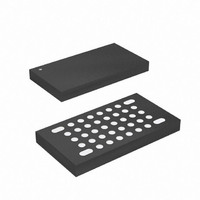ATMEGA16HVA-4CKU Atmel, ATMEGA16HVA-4CKU Datasheet - Page 82

ATMEGA16HVA-4CKU
Manufacturer Part Number
ATMEGA16HVA-4CKU
Description
MCU AVR 16K FLASH 4MHZ 36-LGA
Manufacturer
Atmel
Series
AVR® ATmegar
Datasheet
1.ATMEGA16HVA-4CKU.pdf
(196 pages)
Specifications of ATMEGA16HVA-4CKU
Core Processor
AVR
Core Size
8-Bit
Speed
4MHz
Connectivity
SPI
Peripherals
Brown-out Detect/Reset, POR, PWM, WDT
Number Of I /o
7
Program Memory Size
16KB (8K x 16)
Program Memory Type
FLASH
Eeprom Size
256 x 8
Ram Size
512 x 8
Voltage - Supply (vcc/vdd)
1.8 V ~ 9 V
Data Converters
A/D 5x12b
Oscillator Type
External
Operating Temperature
-20°C ~ 85°C
Package / Case
36-LGA
Processor Series
ATMEGA16x
Core
AVR8
Data Bus Width
8 bit
Data Ram Size
512 B
Interface Type
SPI
Maximum Clock Frequency
4 MHz
Number Of Programmable I/os
6
Number Of Timers
2
Maximum Operating Temperature
+ 85 C
Mounting Style
SMD/SMT
3rd Party Development Tools
EWAVR, EWAVR-BL
Development Tools By Supplier
ATAVRDRAGON, ATSTK500, ATSTK600, ATAVRISP2, ATAVRONEKIT, ATAVRSB200, ATAVRSB201
Minimum Operating Temperature
- 20 C
On-chip Adc
12 bit, 5 Channel
For Use With
ATSTK600 - DEV KIT FOR AVR/AVR32ATSTK500 - PROGRAMMER AVR STARTER KIT
Lead Free Status / RoHS Status
Lead free / RoHS Compliant
- Current page: 82 of 196
- Download datasheet (3Mb)
17.5.5
17.5.6
17.6
82
Input Capture Unit
ATmega8HVA/16HVA
8-bit Input Capture Mode
16-bit Input Capture Mode
The Timer/Counter can be used in a 8-bit Input Capture mode, see
settings. For full description, see
The Timer/Counter can also be used in a 16-bit Input Capture mode, see
for bit settings. For full description, see
The Timer/Counter incorporates an Input Capture unit that can capture external events and give
them a time-stamp indicating time of occurrence. The external signal indicates an event, or mul-
tiple events. For Timer/Counter0, the events can be applied via the PC0 pin (ICP01), or
alternatively via the osi_posedge pin on the Oscillator Sampling Interface (ICP00). For
Timer/Counter1, the events can be applied by the Battery Protection Interrupt (ICP10) or alter-
natively by the Voltage Regulator Interrupt (ICP11). The time-stamps can then be used to
calculate frequency, duty-cycle, and other features of the signal applied. Alternatively the time-
stamps can be used for creating a log of the events.
The Input Capture unit is illustrated by the block diagram shown in
elements of the block diagram that are not directly a part of the Input Capture unit are gray
shaded.
Figure 17-4. Input Capture Unit Block Diagram
The Output Compare Register OCRnA is a dual-purpose register that is also used as an 8-bit
Input Capture Register ICRn. In 16-bit Input Capture mode the Output Compare Register
OCRnB serves as the high byte of the Input Capture Register ICRn. In 8-bit Input Capture mode
the Output Compare Register OCRnB is free to be used as a normal Output Compare Register,
but in 16-bit Input Capture mode the Output Compare Unit cannot be used as there are no free
Output Compare Register(s). Even though the Input Capture register is called ICRn in this sec-
tion, it is referring to the Output Compare Register(s). For more information on how to access
the 16-bit registers refer to
ICPn1
ICPn0
WRITE
OCRnB (8-bit)
TEMP (8-bit)
ICRn (16-bit Register)
”Accessing Registers in 16-bit Mode” on page
”Input Capture Unit” on page
OCRnA (8-bit)
ICSn
”Input Capture Unit” on page
DATA BUS
Canceler
Noise
ICNCn
(8-bit)
TCNTnH (8-bit)
TCNTn (16-bit Counter)
Detector
82.
ICESn
Edge
Table 17-2 on page 80
Figure 17-4 on page
82.
TCNTnL (8-bit)
Table 17-2 on page 80
86.
ICFn (Int.Req.)
8024A–AVR–04/08
82. The
for bit
Related parts for ATMEGA16HVA-4CKU
Image
Part Number
Description
Manufacturer
Datasheet
Request
R

Part Number:
Description:
DEV KIT FOR AVR/AVR32
Manufacturer:
Atmel
Datasheet:

Part Number:
Description:
INTERVAL AND WIPE/WASH WIPER CONTROL IC WITH DELAY
Manufacturer:
ATMEL Corporation
Datasheet:

Part Number:
Description:
Low-Voltage Voice-Switched IC for Hands-Free Operation
Manufacturer:
ATMEL Corporation
Datasheet:

Part Number:
Description:
MONOLITHIC INTEGRATED FEATUREPHONE CIRCUIT
Manufacturer:
ATMEL Corporation
Datasheet:

Part Number:
Description:
AM-FM Receiver IC U4255BM-M
Manufacturer:
ATMEL Corporation
Datasheet:

Part Number:
Description:
Monolithic Integrated Feature Phone Circuit
Manufacturer:
ATMEL Corporation
Datasheet:

Part Number:
Description:
Multistandard Video-IF and Quasi Parallel Sound Processing
Manufacturer:
ATMEL Corporation
Datasheet:

Part Number:
Description:
High-performance EE PLD
Manufacturer:
ATMEL Corporation
Datasheet:

Part Number:
Description:
8-bit Flash Microcontroller
Manufacturer:
ATMEL Corporation
Datasheet:

Part Number:
Description:
2-Wire Serial EEPROM
Manufacturer:
ATMEL Corporation
Datasheet:










